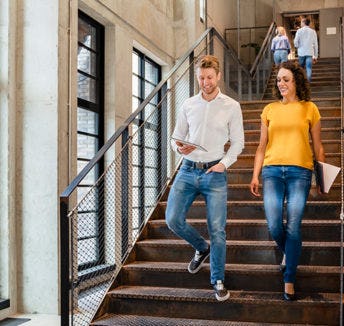
Our work lives are changing and the office needs to keep up. But what do we actually need from the physical workplace now that hybrid working is the norm?
For a while there, offices were beginning to feel a bit like grown up playrooms. Big splashes of primary colours adorned the walls, workers disappeared into squashy bean bags and stayed late to make the most of the beer fridges. And there was no need to rush home because you could take the slide to the office chill zone and fire Nerf bullets at your colleagues instead, and who wouldn’t want that?
Well, it turns out that maybe quite a few people didn’t want that. While there rightly remains an emphasis on creating exciting and inspiring workplaces (offices that are much more than the olden day sea of desks), workers don’t want to feel chained to a particular desk at a particular location – no matter how many perks are included.
The move to home working during lockdown came with the news that not commuting into an office every day is really very nice, and being able to motor through your to-do list without interruptions is also very nice. And productive.
So, as we herald the new era of hybrid working, ‘the office’ in its broadest sense, needs to change. It needs to grow up.
The when and the why
Microsoft’s 2022 Work Trend Index found that globally, more than a third (38%) of hybrid employees said their biggest challenge is knowing when and why to come into the office. The “when” question is easy to answer. Employers need to set out a hybrid strategy that works for them, so that employees are clear on expectations.
But the why… That is more fluid. We have talked before about the role of the office in creating a work community and culture – that is something that can be hard to foster without ever being face to face. With this ‘team’ mindset comes all kinds of positives, such as increased trust, a sense of belonging, and a kind of soft hierarchy where experienced staff can mentor the newbies.
Many industries will also require face-to-face working to bounce ideas around and enable creative discussions. Even if you are not in a so-called ‘creative industry’, most work will benefit from some informal floating of ideas, and offices need to offer the right spaces to enable that.
Agile offices
Microsoft’s Global Workplace Services’ CVP Michael Ford said: “You must design workplaces with enough flexibility to support every employee. A mix of quiet places, collaboration areas, and touch-down locations helps ensure everyone can be connected, engaged, and productive.” Stats show that 54% of leaders globally are currently redesigning meeting spaces for hybrid work, or plan to in the year ahead – perhaps with Ford’s words ringing in their ears. But if we are done with the beanbags, what is it that people now want?
Agility is key. Large spaces around proper sized tables so that people can have effective discussions, as well as smaller café style areas for one-to-ones. There have to be some private areas too. Flexible contracts and the ability to up or down scale, or move locations, are also all part of the modern dream. Running through all of this though, must be technology. Good tech – from high speed internet to an abundance of charging and connecting ports – is key to enabling agility.
Meetings by the beach
Truly hybrid companies may now have more staff than desks. A survey by PWC found that 87% of executives expect to make changes to their real estate strategy over the next 12 months to optimise hybrid working. This includes consolidating office space and reinvesting any savings into making the office a “special experience” for the days that people do come in. Hot-desking technology that allows employees to book desks online and interactive screens showing real-time available spaces can help to build that trust and clarity that employees need. It helps them know where they stand.
New grown-up offices also need meeting rooms that allow those working from home or from a flexible workspace near to them, to dial in and really feel like they have a seat at the table. The days of the fuzzy voice cutting in and out from the speaker in the middle of the table are numbered. Now we have the Metaverse; virtual reality worlds where you can meet as avatars beside a virtual beach, or on a mountain, or as part of a strange 80s video game. It is still playful, but this time it is also inclusive.
Now we think about it, the fun palace offices with all the perks were designed to keep us at our desks for longer. The extracurricular toys and games delayed the need to go home and as William Hanley at Architectural Record argues, they drove an unsustainable work-life balance that is only suited to young men. Hybrid working is the opposite of that. It is inclusive and flexible, while still supporting in-person connection and collaboration. A brilliant modern office that focuses on the thoughtful as well as the fun, is one of the key parts of that process.
Find out more about our grown-up offices, and all that they have to offer by browsing Spaces offices and locations.
Share this article
 Read now The sitting issue: Why it’s time to stand up and start moving
Read now The sitting issue: Why it’s time to stand up and start moving
 Read now How the ‘worth it equation’ is re-humanising the workplace
Read now How the ‘worth it equation’ is re-humanising the workplace